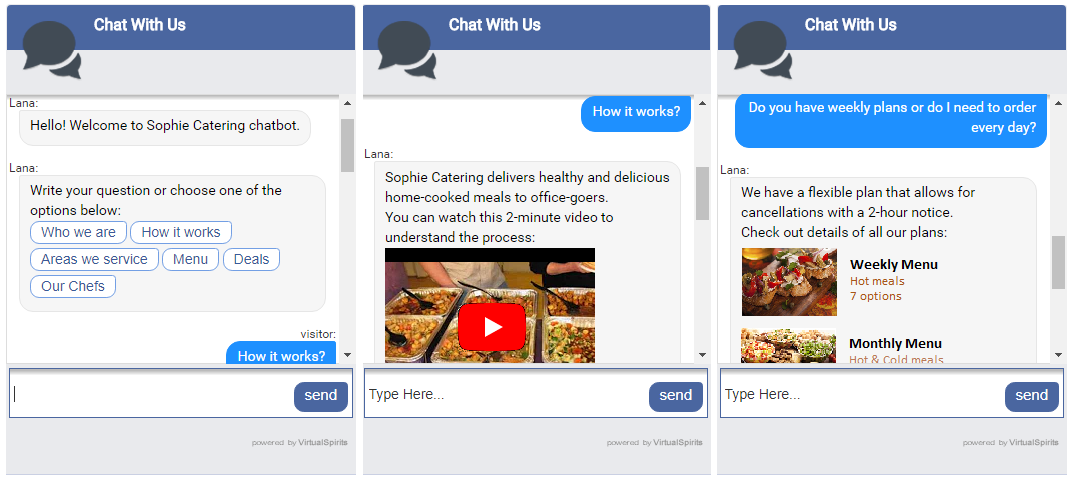
TOPICS:
Chatbot for Businesses Chatbot for Lead Generation Chatbot Optimization
Chatbots for Small Businesses – How to Use Bots to Increase Sales
There are industry-specific advantages of building chatbots for websites, but if yours is a small business, it’s going to need a chatbot regardless of the industry within which it functions.
The kind of competition that new businesses find themselves in today has never been dealt with before. Consumer preferences change at a moment’s notice, and marketing techniques must reinvent themselves to keep up. Given all this, a tool that lets you automate so many of your customer interactions, and save money to boot, becomes an indispensable asset.
But efficient and inexpensive customer service isn’t all that a small business chatbot brings to the table. Lots of new businesses are using chatbots to increase sales through their websites. Here’s how they do it, and how you can too.

Chatbots for small business hold your customers’ attention.
If you’ve tried negotiating the tricky waters of online marketing, you’re probably familiar with the difficulties of trying to increase visitor engagement on your website. The usual methods, like making an attractive “how it works” section, might work to an extent, but once the visitor has read it through, and there’s nothing else to hold their attention, they could move on to someplace else. Even putting up an interesting video often leads to the same result.
Enter online chatbots. Now, we aren’t suggesting that chatbots can replace engaging content. Rather, we mean that chatbots work in tandem with your content, to keep visitors engaged for longer periods of time. Let’s take an example. Alicia, a 25-year-old working professional, has arrived at the website of a local business that delivers daily lunches to offices. Alicia wants to know exactly how the service will work, how many days she’ll have to sign up for, whether she’ll have the option of changing the menu at short notice, and so on.
If the website doesn’t have a chatbot, Alicia will follow the usual routine of browsing through the homepage, the “how it works” section, and perhaps the menu. If she finds a video, she’ll probably prefer watching it over trying to make sense of several pages of text. But at the end of the video, Alicia will continue to have questions that are specific to her needs and preferences. She’ll have to look for answers on the website’s help section. If she’s lucky, she might find her question in the FAQs, and if not, she’ll need to email or call the support team.
Regardless of whether or not Alicia finds the information she needs, this process is complicated and long drawn out. There’s a good chance that if it takes more than a few minutes to figure it out, Alicia will just move on to a different service. This is where the presence of an online chatbot helps.
The prominent “live chat” window on the website encourages Alicia to ask her questions there instead of browsing multiple webpages. She opens the window and the chatbot greets her with a friendly hello.
Chatbot:
“Hello, and welcome to ABC Lunches! What can I help you with today?”Alicia sees a menu of options such as “who we are”, “how it works”, “areas we service”, “menu”, and so on. She clicks the “how it works” option.
Chatbot:
“ABC Lunches delivers healthy and delicious home-cooked meals to office-goers. You can watch this 2-minute video to understand the process…”Alicia watches the short explanatory video. She now has a good idea of how the service works, but also has a few questions.
Alicia:
“Do you have weekly plans or do I need to order every day?”Chatbot:
“We have a flexible plan that allows for cancellations with a 2-hour notice. Check out details of all our plans here.”Alicia:
“Do you service [Locality]?”Chatbot:
“Yes, we do! You can check out a map of our serviced locations right here.”As can be seen from the above conversation, Alicia finds the chat window to be a quick and easy source of information that actually encourages her to stay and get all her questions answered. At the end of the interaction, Alicia has a good chance of buying the service for a week. At the very least, she leaves with a good first impression and will seriously consider opting for this particular lunch service when the time comes for her to make a decision.
Chatbots for small business give you useful insights about your customers.
Staying relevant despite the competition is one of the biggest challenges for small businesses today. Building chatbots for small business is an effective way to overcome it. In our recent example, it wasn’t just Alicia who was able to get information through her interaction with the online chatbot. Her questions and responses to the chatbot also serve as valuable feedback that the owners of the lunch delivery service need in order to assess their current appeal to their target audience.
The high demand for small business chatbot development is largely due to this advantage. Chatbots create a direct line of communication with your users, letting you understand their changing needs and preferences, and helping you make the right changes or additions to your offerings or marketing strategies. The best chatbots for small business websites often have customer survey questionnaires built into their scripts to further facilitate this process. So if Alicia happens to return to the ABC Lunches website after using the service for a month, the chatbot can ask her something like,
“We’d love to hear your thoughts on how we’re doing and where we should improve. Would you have a couple of minutes for a super-quick survey?”Small business chatbots offer a personalized experience.
As a small business owner, you’d be well aware of the importance of lead nurturing. You’d also be just as aware of how much time and effort it takes to guide your potential customers through the sales funnel. If you create a chatbot for your website, though, your task could become much easier.
As we discussed in the previous section, chatbots give you useful insights about your website’s visitors. When it comes to potential customers, chatbots give you clues about what they’re most interested in, and help you create personalized sales conversion funnels for them. So if the ABC Lunches chatbot comes across multiple instances where Alicia enquires about vegan foods, it can pitch her discounts on the service’s vegan menu, encouraging her to finalize her purchase. Getting the same results manually would be way more tedious and time-consuming.
Instant chat windows make for excellent ‘billboards’.
When you create a chatbot for your small business website, you’ve essentially created a robust marketing tool that you can put to multiple uses at once. Besides answering your visitors’ questions, offering them support when they become paying customers, and collecting feedback from them, your online chatbot can also display a variety of promotional and informational content right there on the chat window. The best chatbots for small businesses have product promotions and information on new releases intelligently built into their chat script, so the average visitor sees the content at relevant stages of the conversation. Pitching new products in this ‘organic’ fashion is usually successful in getting visitors to respond positively – much more so than promotional emails and website banners.
Keep following our blog for more information on building chatbots for small business websites and other platforms, or get in touch with us for help with your chatbot development needs.